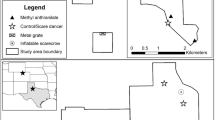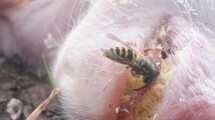Abstract
The Brown Treesnake (Boiga irregularis) is invasive in Guam and threatens to be dispersed by military and civilian transportation activities to other islands in the Pacific, where it could be expected to inflict similar damages. Prevention of inadvertent export of snakes in cargo and vehicles currently relies on trained canine detection teams, which are expensive to use and unable to detect all snakes. Hence, there has long been interest in developing effective and cheaper means of fumigating cargo to remove snakes. A companion study has shown that chemical fumigation is unlikely to be readily developed into a practical tool. Here, we demonstrate that these snakes are readily induced to quit test refugia by application of streams of heated air. Many parameters affect snake response times, but we find that application of relatively low temperatures (48–52 °C) at moderate delivery rates (3.4 m3/min) is sufficient to induce exit of these snakes within 5 min. Development of a portable heat-delivery system based on these findings has great potential to ensure snakes do not unintentionally stow away to other locations in cargo, munitions, vehicles, or airplane wheelwells. Application of such technology can be done on Guam as well as at locations receiving cargo or vehicles from that source, providing an additional layer of security in ensuring these snakes do not colonize additional locations outside their native range.

Similar content being viewed by others
References
Brattstrom BH (1965) Body temperatures of reptiles. Am Midl Nat 73:376–422
Brown Tree Snake Control Committee (1996) The brown tree snake control plan. Final report. Aquatic Nuisance Species Task Force, Brown Tree Snake Control Committee, U.S. Fish and Wildlife Service, Honolulu
Burnett K, Kaiser B, Pitafi BA, Roumasset R (2006) Prevention, eradication, and containment of invasive species: illustrations from Hawaii. Agric Resour Econ Rev 35:63–77
Campbell GS (1977) An introduction to environmental biophysics. Springer, New York
Christy MT, Savidge JA, Bischof R, Rodda GH (2007) Can temperature be used as a tool for limiting brown treesnake invasion via transportation pathways? In: Witmer GW, Pitt WC, Fagerstone KA (eds) Managing vertebrate invasive species: proceedings of an international symposium. USDA/APHIS/Wildlife Services, National Wildlife Research Center, Fort Collins, pp 246–256
Clark L, Shivik J (2002) Aerosolized essential oils and individual natural product compounds as brown treesnake repellents. Pest Manag Sci 58:775–783
Engeman RM, Vice DS (2002) Objectives and integrated approaches for the control of brown tree snakes. Integr Pest Manag Rev 6:59–76
Engeman RM, Vice DS, Rodriguez DV, Gruver KS, Santos WS, Pitzler ME (1998) Effectiveness of detector dogs for locating brown tree snakes in cargo. Pac Conserv Biol 4:256–260
Engeman RM, Vice DS, York D, Gruver KS (2002) Sustained evaluation of the effectiveness of detector dogs for locating brown tree snakes in cargo outbound from Guam. Intern Biodeterior Biodegrad 49:101–106
Fritts TH (1988) The brown tree snake, Boiga irregularis, a threat to Pacific islands. US Fish Wildl Serv Biol Rep 88(31):1–36
Fritts TH, Chiszar D (1999) Snakes on electrical transmission lines: patterns, causes, and strategies for reducing electrical outages due to snakes. In: Rodda GH, Sawai Y, Chiszar D, Tanaka H (eds) Problem snake management: the habu and brown treesnake. Comstock Publ, Ithaca, pp 89–103
Fritts TH, McCoid MJ (1991) Predation by the brown tree snake Boiga irregularis on poultry and other domesticated animals in Guam. Snake 23:75–80
Fritts TH, McCoid MJ (1999) The threat to humans from snakebite by snakes of the genus Boiga based on data from Guam and other areas. In: Rodda GH, Sawai Y, Chiszar D, Tanaka H (eds) Problem snake management: the habu and brown treesnake. Comstock Publ, Ithaca, pp 116–127
Fritts TH, Rodda GH (1998) The role of introduced species in the degradation of island ecosystems: a case history of Guam. Ann Rev Ecol Syst 29:113–140
Fritts TH, Scott NJ Jr, Savidge JA (1987) Activity of the arboreal brown tree snake (Boiga irregularis) on Guam as determined by electrical outages. Snake 19:51–58
Fritts TH, McCoid MJ, Haddock RL (1990) Risks to infants on Guam from bites of the brown tree snake (Boiga irregularis). Am J Trop Med Hyg 42:607–611
Fritts TH, McCoid MJ, Haddock RL (1994) Symptoms and circumstances associated with bites by the brown tree snake (Colubridae: Boiga irregularis) on Guam. J Herpetol 28:27–33
Heatwole H (1976) Reptile ecology. University of Queensland Press, Brisbane
Huey RB, Stevenson RD (1979) Integrating thermal physiology and ecology of ectotherms: a discussion of approaches. Amer Zool 19:357–366
Nishimura M (1999) Repellents and use of prey items for delivering toxicants for control of habu (Trimeresurus flavoviridis). In: Rodda GH, Sawai Y, Chiszar D, Tanaka H (eds) Problem Snake Management: Habu and Brown Tree Snake Examples. Cornell University Press, Ithaca, pp 158–167
Olmsted J III, Williams GM (1997) Chemistry: the molecular science. William C. Brown Publishers, Dubuque
Perry G, Vice DS (2007) An evaluation of passive thermal fumigation from brown treesnake control in surface transportation from Guam. In: Witmer GW, Pitt WC, Fagerstone KA (eds) Managing vertebrate invasive species: proceedings of an international symposium. USDA/APHIS/Wildlife Services, National Wildlife Research Center, Fort Collins, pp 224–233
Robertson JM (2011) Status report: the Guam military buildup. Mil Eng 672:73–74
Rodda GH, Savidge JA (2007) Biology and impacts of Pacific Island invasive species. 2. Boiga irregularis, the brown tree snake (Reptilia: Colubridae). Pac Sci 61:307–324
Rodda GH, Fritts TH, Chiszar D (1997) The disappearance of Guam’s wildlife: new insights for herpetology, evolutionary ecology, and conservation. BioSci 47:565–574
Savidge JA (1987) The ecological and economic impacts of an introduced snake on Guam and its threat to other Pacific islands. Pac Life Environ Stud 3:29–34
Shwiff SA, Gebhardt K, Kirkpatrick KN, Shwiff SS (2010) Potential economic damage from introduction of brown treesnakes, Boiga irregularis (Reptilia: Colubridae), to the islands of Hawai’i. Pac Sci 64:1–10
Vice DS, Vice DL (2004) Characteristics of brown treesnakes Boiga irregularis removed from Guam’s transportation network. Pac Conserv Biol 10:216–220
Vice DS, Engeman RM, Hall MA, Clark CS (2009) Working dogs: the last line of defense for preventing dispersal of brown treesnakes from Guam. In: Helton WS (ed) Canine ergonomics: the science of working dogs. CRC Press, Boca Raton, pp 195–204
Acknowledgments
This study was approved as NWRC Protocol QA-1837 and funded by the Department of Interior’s Office for Insular Affairs. Support for initial work on this project was provided to FK by Mississippi State University’s Department of Wildlife, Fisheries & Aquaculture. We thank C. Clark, J. Guerrero, T. Salas, and D. Vice for assistance on Guam, and the AAFB snake crew for providing us with test animals and for their kind tolerance of our invasion of their work space.
Author information
Authors and Affiliations
Corresponding author
Additional information
Communicated by J. Jacob.
Rights and permissions
About this article
Cite this article
Kraus, F., Stahl, R. & Pitt, W. Thermal fumigation provides a simple and effective solution for sanitizing cargo from invasive snakes. J Pest Sci 88, 331–341 (2015). https://doi.org/10.1007/s10340-014-0627-x
Received:
Revised:
Accepted:
Published:
Issue Date:
DOI: https://doi.org/10.1007/s10340-014-0627-x




